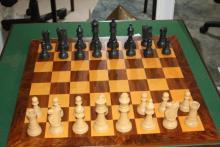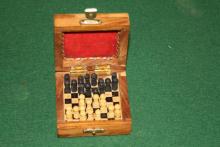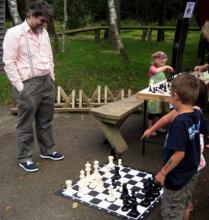Peter Lane, 10 June 1997
Akiba Rubinstein made enormous contributions to the game of chess. In the first place, our opening books contain Rubinstein's lines in the Nimzo-Indian (1.d4 Nf6 2.c4 e6 3.Nc3 Bb4 4.e3), the Tarrasch Defense (1.d4 d5 2.c4 e6 3.Nc3 c5 4.cxd5 exd5 5.Nf3 Nc6 6.g3), the Four Knights' Game (1.e4 e5 2.Nf3 Nc6 3.Nc3 Nf6 4.Bb5 Nd4) and the French Defense (1.e4 e6 2.d4 d5 3.Nc3 dxe4). Secondly there is the legacy of his games, containing some superb endgames (Reuben Fine believing he ranked above Capablanca in this respect) and a middlegame style based upon a preference for the attack.The games selected here will focus upon Rubinstein's attacking skill. My reasons for this are twofold. Firstly, I have been reading Vukovic's `Art of Attack in Chess', and you can see this selection as my attempt to understand some of the principles! Secondly, his combinational style was a method which permeated all areas of the game, as we will see in his clash with Capablanca.
- Game 1 : Rubinstein's Immortal
- Game 2 : Refuting Unsound Opening Play
- Game 3 : Causing Chaos
- Game 4 : Pawn Storm
- Game 5 : A Clash of Titans
- Further Reading:
Game 1 : Rubinstein's Immortal
Rotlewi vs A.R., Lodz 1907/8, Queen's Gambit Declined.
1.d4 d5 2.Nf3 e6 3.e3 c5 4.c4 Nc6 5.Nc3 Nf6 6.dxc5 Bxc5 7.a3 a6 8.b4 Bd6 9.Bb2 O-O 10.Qd2?Only 10.cxd5 exd5 11.Be2/d3 could save the opening.
10. ... Qe7! 11.Bd3 dxc4 12.Bxc4 b5 13.Bd3 Rd8 14.Qe2 Bb7 15.O-O Ne5 16.Nxe5 Bxe5 17.f4 Bc7 18.e4 Rac8 19.e5
2rr2k1/1bb1qppp/p3pn2/1p2P3/1P3P2/P1NB4/1B2Q1PP/R4RK1
|
19. ... Bb6+ 20.Kh1 Ng4! 21.Be4
Of course 21.Qxg4 Rxd3 is strong. 21.Ne4 Rxd3 22.Qxd3 Bxe4 23.Qxe4 Qh4 24.h3 Qg3 25.hxg4 Qh4 'mate begins to reveal the danger White is in.
21. ... Qh4 22.g3
2rr2k1/1b3ppp/pb2p3/1p2P3/1P2BPnq/P1N3P1/1B2Q2P/R4R1K
|
if 23.Bxc3 Bxe4+ 24.Qxe4 Qxh2 'mate, or 23.Bxb7 Rxg3 24.Rf3 Rxf3 25.Bxf3 Nf7+ 26.Kg1 Ne4+ 27.Kf1 Nd2+ 28.Kg2 Nxf3 29.Qxf3 Rd2+ etc.
23. ... Rd2!! 24.Qxd2
if 24.Qxg4 Bxe4+ 25.Rf3 Rxf3 etc, 24.Bxc3 Rxd2 with Rxh2 'mate or Bxe4+ 'mate to follow, or 24.Bxb7 Rxe2 25.Bg2 Rh3! etc.
24. ... Bxe4+ 25.Qg2 Rh3! 0-1
'mate in three follows, 26.Rf3 Bxf3 27.Bd4 Bxd4 and Rxh2 'mate.
This game is breathtaking, but Rubinstein also played games in a style which is perhaps more easy to interpret and emulate. The next three I hope come into this category.
Game 2 : Refuting Unsound Opening Play
A.R. vs Dr. Tartakower, Kissingen 1928, Budapest Defense.
1.d4 Nf6 2.c4 e5 3.dxe5 Ng4 4.Bf4 Bb4+ 5.Nd2 Nc6 6.Nf3 f6Black avoids the mainline, 6...Qe7 7.a3 Ngxe5 8.Nxe5 Nxe5 9.e3 Bxd2+ 10.Qxd2 and White is visibly superior. White's line is a recommendation of Dr. Bernstein, and designed to retain the two bishops - an important point for A.R., as we will see.
7.exf6 Qxf6 8.g3!
This is the Rubinstein touch - offering back the pawn in exchange for superior development.
8. ... Qxb2 9.Bg2 d6 10.O-O O-O
r1b2rk1/ppp3pp/2np4/8/1bP2Bn1/5NP1/Pq1NPPBP/R2Q1RK1
|
This move is quite subtle. Black's opening is based upon the hope of active piece play, but now his pieces are looking uncoordinated, and White is well developed. In situations of this kind, it is important to gain and keep the initiative, primarily through attacking and removing your opponent's best pieces. With this in mind, A.R. plans to exchange the Bb4 for a knight, drive back the Ng4, and use his two bishops and central control to break through.
11. ... Qf6 12.Ng5 h6 13.Ne4 Qf7
if 13. ... Qe7 14.a3 Bc5 (not Ba5 15.Nxa5 and Qd5+) 15.Nexc5 dxc5 16.Qd5+ Be6 17.Qxc5 Qxc5 18.Nxc5 Bxc4 19.Rfc1 Bxe2 20.Nxb7 wins a pawn.
14.a3 Ba5 15.Nxa5 Nxa5 16.h3! Ne5
We begin to see some of Black's problems: 16...Nf6? 17.Nxf6+ Qxf6 18.Qd5+xa5 or 17...gxf6 18.Bxh6
17.c5!
showing that e5 is not a strong point for the knight, only a cover for the d6 pawn. Notice how Black's pieces are kept on the run.
17. ... g5?
Black should centralise: 17...Nac4 18.cxd6 Rd8 maintains complications.
18.Bd2 d5 19.Nxg5 hxg5 20.Bxa5 Be6 21.Bc3 Nc6
r4rk1/ppp2qpp/2n1b3/2Pp2p1/8/P1B3PP/4PPB1/R2Q1RK1
|
22.Qd2 Qf5 23.g4 Qf4 24.Bxd5 Bxd5
of course, 24...Qxd2 25.Bxe6+. Notice the deflection of the overloaded Black queen.
25.Qxd5+ Kh7 26.e3! Qf3 27.Qxg5 Qxh3 28.Qg7 'mate
(If 27...Q/Rf7 28.Qh4+ and 'mate.)
This game demonstrates three very important principles of Rubinstein's play:
1. Use of the bishops, note the Bf4-d2-c3 manoeuvre, changing the attack point from d6 to g7.
2. Attacking the opponent's pieces to prevent development and consolidation.
3. By maintaining the initiative in the centre, a weakened king's side can be punished with a swift kill.
Game 3 : Causing Chaos
A.R. vs Dr. Tarrasch, Hastings 1922, Dutch Defense.
1.d4 e6 2.c4 f5 3.g3 c5This line looks an active central attack, but creates weaknesses. Nf6 or Bb4+ are superior. Notice how A.R. develops smoothly, not attempting a refutation.
4.Nf3 cxd4 5.Nxd4 Nf6 6.Bg2 Nc6 7.O-O Bc5 8.e3 O-O 9.Nc3 a6
Neither b6 nor d6 are playable due to Nxc6, and Qc7 is met by Nb5, but this passive move gives A.R. the chance to gain some queen side space.
10.a3 Qc7 11.b4 Be7 12.Bb2 Ne5
if 12...d6 13.e4 opens the game to White's advantage, but this tempting line is flawed. Vukovic gives a useful comment to bear in mind: `the use of force from a weaker position usually prompts a still more forceful reply from one's opponent'.
13.c5 Nc4
r1b2rk1/1pqpb1pp/p3pn2/2P2p2/1PnN4/P1N1P1P1/1B3PBP/R2Q1RK1
|
And this is it! Qb3 would follow the capture of the knight, but that is not the full story...
14. ... Bxc5 15.bxc5 Qxc5 16.Nh6+
This is the real point. The combination has removed the dark square bishop, wrecked the Black king side, and gained the initiative, at the cost of a pawn. (Note 14...Nxb2 15.Nxe7+ and Qb3 won a pawn, but 15...Nxb2 16.Ne7+ Kf7 17.Qe2 seems no worse than the game, and White has lost a bishop.)
16. ... gxh6 17.Bc1 Qe5? 18.Qd3! Qc5
Oh dear, but if 18...Nb6 19.Bb2, or 18...d5 19.e4. Better was 17...d6 or Rb8 to continue developing.
19.a4! d6 20.e4
This is now playable, because his previous move prevented ...b5 20. ... Kg7 21.Nd1!
Painfully simple chess - the Nc4 must go!
21. ... Bd7 22.Ne3 b5 23.Nxc4 bxc4 24.Qd2 Ne8 25.e5!
r3nr2/3b2kp/p2pp2p/2q1P3/P1p5/6P1/3Q1PBP/R1B2RK1
|
25. ... Rab8 26.Qxh6+ Kg8 27.Qg5+ Kf7 (if 27...Kh7 28.Qe7!) 28.Bf3! Rg8 29.Qh5+ Kg7 30.Be4! Qxe5
what else? 30...Rh8 31.Bh6+ Kg8 32.Qg5+ Kf7 33.Qf4+ wins.
31.Qxh7+ Kf8
if 31...Kf6 32.Qxg8 Qxe4 33.Bg5+ Kf5 34.Qh7+ etc.
32.Qxd7 Qxe4 33.Bh6+ 1-0
as White wins a rook after 33...Ng7 34.Bxg7+ Rxg7 35.Qxd7+xb8
This game shows the same three characteristics:
1. The bishops reign supreme.
2. Removing the opponent's better pieces (Be7 and Nc4).
3. Taking the initiative, and not letting it go.
Game 4 : Pawn Storm
A.R. vs Teichmann, Vienna 1908, Queen's Gambit Declined.
1.d4 d5 2.c4 e6 3.Nc3 Nf6 4.Bg5 Nbd7 5.e3 Be7 6.Nf3 O-O 7.Qc2 b6Better is 7...c5. For this line to be playable, Black must keep the queen's knight at home to cover the White squares, and play ...h6 in preference.
8.cxd5 exd5 9.Bd3 Bb7 10.O-O-O c5 11.h4
r2q1rk1/pb1nbppp/1p3n2/2pp2B1/3P3P/2NBPN2/PPQ2PPQKR3R
|
This move always seems to be a critical error by Black in Queen's side openings - it blocks the position, and White's attack is quicker. The position is one of opposite side castling, and the central formation is, at the moment, fixed. Therefore the plan is one of pushing pawns at the opponent's king. This is not because the pawns make the best attackers - pieces prefer to deliver 'mate - but because we need to open lines of attack, especially files for the rooks. Black's plan is therefore indicated: 11...cxd4 to open the c-file, followed with ...Rc8...a6...b5
12.Bf5 Re8 13.Bxf6!
This is most instructive. When playing an attack involving a pawn storm every tempo becomes critical, and it is particularly important to prevent your opponent making good defensive moves. In this position Black wants to cover his h7 pawn with the move ...Nf8. White's plan is to push his g-pawn, and for this purpose the Bg5 is an obstruction. It would also be pleasant if the move g5 were to gain a tempo against a Nf6. Therefore this move, which gets rid of the obstruction, prevents the defensive Nf8, and forces Black to keep a knight on f6 ready to be attacked by the advancing pawn. Finding moves like this is necessary if your attack is to keep on rolling!
Finally we must remember to be flexible in attack, if Black had played 12...g6 13.Bxd7 and Bh6 would have followed.
13. ... Nxf6 14.g4 Bd6 15.g5 Ne4 16.h5 Qe7
The pawns just keep moving up the board, and Black has yet to move on the queen-side. Note: 16...Nxg5 17.Nxg5 Qxg5 18.Bxh7+ Kf8 19.h6 gxh6 20.Rdg1 and `etc' say the commentators. After 20...Qf6 21.Rh5 Qe6 22.Rgh1 does look good.
17.Rdg1 a6
r3r1k1/1b2qppp/pp1b4/3p1BPP/2pPn3/2N1PN2/PPQ2P2/2K3RR
|
Therefore, White is free to sacrifice a piece to prevent any blockade.
18.Bxh7+! Kxh7 19.g6+ Kg8
if 19...fxg6 20.Nxe4 dxe4 21.Ng5+ Kg8 22.Qxc4+ or 21...Kh6 22.Nf7+ Qxf7 23.hxg6+ etc
20.Nxe4 dxe4 21.h6 f6?
Tougher is 21...fxg6 22.Nh4 g5 23.Ng6 Qf6 24.h7+ Kf7 25.h8(Q) Rxh8 26.Nxh8+ Ke7 leaving White to extricate his knight.
A.R. missed 21.Ng5 Bd5 22.gxf7+ Bxf7 23.f3! Bd5 (else 24.fxe4-e4) 24.h6! coupling a central break through with the king-side attack,
e.g. 24...Rac8 25.fxe4 Bxe4 26.h7+ Kh8 27.Qxe4! Qxg5 28.Qxe8+ wins.
22.hxg7 exf3
if 22...Qe6 23.Rh8+ Kxg7 24.Rh7+ and Rgh1 will force 'mate.
23.Rh8+ Kxg7 24.Rh7+ Kg8 25.Qf5 c3
if 25...Qe6 26.Qh5
26.Rxe7 1-0
as 26...Rxe7 27.Qxf6 and Rh1 'mates.
Game 5 : A Clash of Titans
A.R. vs J.R. Capablanca, San Sebastian 1911, Tarrasch Defense.
1.d4 d5 2.Nf3 c5 3.c4 e6 4.cxd5 exd5 5.Nc3 Nc6 6.g3Black's opening was held by Tarrasch: `to be the best, although I must add that I am almost completely alone in holding that opinion. It is based upon the undeniably correct idea that in the Queen's Gambit ...c5 is the freeing move for Black, and must therefore be made as soon as possible. With this defense Black gets a fine free game for his pieces, at the cost of isolating his Queen's Pawn'.
And for those who worry about that `cost'? `He who fears an isolated Queen's Pawn should give up chess'. (Tarrasch referred to this debate as Tarrasch contra mundum).
A.R.'s enduring contribution was a plan involving a fianchetto of the king's bishop, bringing it to bear on the pawn at d5. This simple scheme was used by Karpov to defeat Kasparov twice in 1985.
6. ... Be6
Capablanca used this line against Marshall in 1909, winning his `most accurate game', but 6...Nf6 7.Bg2 Be7 8.O-O O-O is preferable.
7.Bg2 Be7 8.O-O Rc8 9.dxc5 Bxc5 10.Ng5!
White can begin an attack while Black still lacks two moves for castling. Notice that the initiative is used to make the most of a development edge.
10. ... Nf6 11.Nxe6 fxe6 12.Bh3
Again, the mobile bishop - h3-c8 is now the crucial light diagonal.
12. ... Qe7 13.Bg5 O-O
Black has finally caught up in development, but A.R. has been preparing his middle game plans - watch the board explode!
14.Bxf6 Qxf6 15.Nxd5!
2r2rk1/pp4pp/2n1pq2/2bN4/8/6PB/PP2PP1P/R2Q1RK1
|
Of course, 15...exd5 16.Qxd5+ and Bxc8 or 15...Bxf2+ 16.Kg2 Qh6 17.Nf4 and 18.Bxe6+xc8 win quickly for White. Instead Capablanca puts another piece under attack, and prepares to pin the knight: who's winning?
16.Kg2 Rcd8 17.Qc1!!
A.R. of course! 17...Rxd5 fails to 18.Qxh6 and 19.Bxe6+, so White wins at least a pawn.
17. ... exd5 18.Qxc5 Qd2 19.Qb5 Nd4 20.Qd3 Qxd3 21.exd3 Rfe8
3rr1k1/pp4pp/8/3p4/3n4/3P2PB/PP3PKP/R4R2
|
Black's better development make White's win hard work, at best. 22.Rae1 Nc2 23.Rxe8+ Rxe8 leaves both Nb4 and Ne1+xd3 threatened. White must work up something with his rooks, and try to dislodge that knight on d4. Both players are legends in the endgame, and the following moves unfold an epic battle.
22. ... Rd6 23.Rfe1 Rxe1 24.Rxe1 Rb6 25.Re5!
Rooks must be active. 25.b3 Ra6 and 25.Rb1 would be deplorably passive.
25. ... Rxb2 26.Rxd5 Nc6
as 26...Nb5 27.Rd8+ Kf7 28.Rd7+xb7 loses and 26..Nc2 leaves the knight out of the game. Now watch the White pieces jockeying for the best places: the rook to attack the pawns on the 7th rank, the bishop to cover the a2 pawn, not forgetting to drive the defending king away!
27.Be6+ Kf8 28.Rf5+ Ke8
if 28...Ke7 29.Bc4 with Rf7 to come.
29.Bf7+ Kd7
The king must come forward now to gain counterplay.
30.Bc4 a6
To prevent Rb5 swapping the rooks, and now White is free to gain some pawns.
31.Rf7+ Kd6 32.Rxg7 b5 33.Bg8 a5 34.Rxh7 a4 35.h4 b4 36.Rh6+
The Black pawns are beginning to look worrying, and White must take counter measures.
36. ... Kc5 37.Rh5+ Kb6 38.Bd5? b3?
Missing the chance to play 38...Rxa2! as 39.Bxa2 b3 40.Bxb3 axb3 will queen the pawn, but 39.Bc4 Rc2 40.Rb5+ Kc7 41.Bg8 is still winning.
On White's side a better line was 38.Bc4 b3 39.Rb5+ Kc7 40.Bxb3 axb3 41.axb3 winning comfortably.
We now get a finely calculated finish.
39.axb3! a3 40.Bxc6! Rxb3
if 40...a2 41.Rb5+ Ka6 42.Rb8
41.Bd5 a2 42.Rh6+ 1-0
because 42...Ka5/a7 43.Rh8-a8, or if 42...Kb5 43.Bc4+ and Ra6.
Further Reading:
Rubinstein's Chess Masterpieces, by Hans Kmoch.The Art of Attack in Chess, by V. Vukovic.























































































